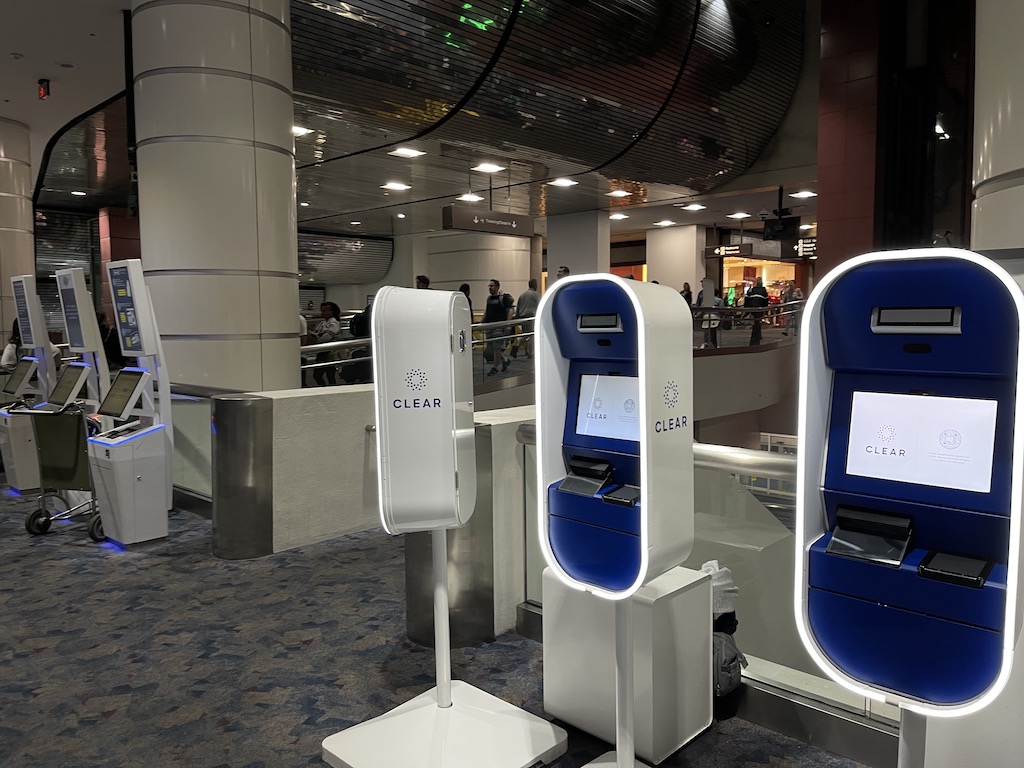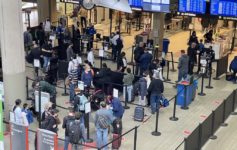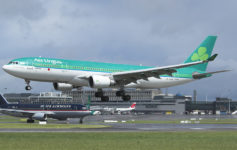CLEAR, the airport security expediting line is a great perk to utilize but its limited airport footprint remains a problem, here’s my solution.
If you are considering booking travel or signing up for a new credit card please click here. Both support LiveAndLetsFly.com.
If you haven’t followed us on Facebook or Instagram, add us today.
CLEAR’s Current Airport Footprint
With the advent of enhanced security screening following 9/11 over 20 years, ago, expedited airport security has been the desire of frequent flyers throughout the United States and CLEAR answered that call. CLEAR provides background information to allow faster movement through TSA checkpoint security lines with fewer hassles.
Regardless of whether a passenger is a member of a Trusted Traveler Program (like TSA Precheck members) once a CLEAR member is verified by scanning their boarding pass and either their iris or fingerprint they are moved to the front of the line (including the TSA Precheck line if they qualify) and proceed through security from there.
CLEAR has grown by leaps and bounds but still doesn’t touch many frequent travelers throughout the country.
Pittsburgh serves 6.7MM passengers annually, Kansas City serves about 7.6MM, Tampa welcomes 18MM, to the south in Fort Myers, RSW processes 10.3MM, and Portland sees nearly 12MM – none of these airports have CLEAR but Birmingham, Alabama, Westchester, and Greenville-Spartanburg do. In total, the program offers 40+ airports but even Omaha sees 5MM passengers annually – nearly Birmingham and Westchester passenger totals combined – can’t get a single CLEAR machine and employee.
Even when holding a presence at an airport, sometimes CLEAR operates in a limited capacity where most travelers don’t interact with the service. For example, Chicago O’Hare offers CLEAR at Terminals 1, 2, and 5 but American’s busy Terminal 3 goes without stations. At Dallas/Fort Worth, Terminal E has a CLEAR station, but Terminals A, B, C, and D have nothing. For those noticing a trend, Charlotte doesn’t have a single station either. More on that later.

Chicken and Egg Situation
The company’s operation is no doubt expensive. Maintaining software and security protocols acceptable to the Transportation Security Administration can’t be cheap. With expensive operations comes limited expansion. But without more expansion, travelers won’t interact with the brand and see its value. Without more travelers, new airport expansion is an expensive, cash-heavy risk.
It’s a classic chicken and egg situation: CLEAR can’t expand without more paying customers, but it’s hard to get more paying customers without a more usable service.
A Solution to CLEAR’s Footprint Issue
Smaller Setup
When examining CLEAR’s setup, one thing is obvious: they could get away with less at mid-tier airports. For example, rather than a fleet of terminals and 5-10 employees as they operate in busy terminals like Newark’s Terminal C, a reduced number of stations and staff could help. Take an airport like Pittsburgh International, my home airport. There are two security checkpoints, the second opened in a temporary facility to deal with passenger overflow. A single station and employee that moved qualified passengers through expedited airport security could make some travelers passionate, loyal customers.
Airport Sponsorship
Airports in competitive markets and those looking to attract new flyers might want to clear the way for the company to setup a station. This could include offering free real estate near the checkpoints, office space, and parking or even a financial incentive to bring the service onboard. Airports are already in the habit of sponsoring new routes to grow the airport’s footprint and attractiveness to flyers, why not add services?
More Airline Partnerships
United and Delta already include a reduced fee or free membership to CLEAR for elite frequent flyers. Adding American Airlines to the mix (and financial support to expand at key airports) would add to the mix. Southwest has good representation at hubs in Baltimore, Chicago Midway, Dallas-Love, and Houston-Hobby, JetBlue Airways at JFK, Boston, and Fort Lauderdale leaving American as the most attractive candidate. Alaska has coverage in Seattle but Anchorage, Honolulu, and Portland could add key airports and travelers to the mix.
More Credit Card Partnerships
CLEAR membership is included for those who hold a Platinum card from American Express, each membership allowing travelers to add up to three family members ($50/adult, under-18 children are complimentary.) As discussed last week, the premium travel credit card space is competitive with compelling products offered by Citi, Chase, and Capital One, not to mention the premium co-brand cards like Marriott, Hilton, and hopefully Hyatt.
Adding a CLEAR membership (even though the cost would be heavily discounted from retail prices) as a credit card benefit as AMEX has done would create value for premium customers and allow CLEAR to add more cities with more cash.
Conclusion
CLEAR has done a great job expanding to new airports but they miss vast swaths of the country and its travelers by not having a greater footprint. With additional credit card relationships, adding American Airlines, airport sponsorships, and reduced initial investment, CLEAR could grow to even more airports and build its customer base. Without those revenue sources, it will remain hard for CLEAR to add the airports needed to make the service ubiquitous with a good travel experience.
What do you think? Are these solutions the way to grow CLEAR’s footprint? Do you have other ideas for expansion?



MCI is supposed to have CLEAR when the new terminal opens next year.
Family members are now $60 each
Chicago and Dallas don’t have Clear available in terminals that American controls simply because American decided they didn’t want to make their frequent flyers lives easier with technology that makes money for Delta and United (who invested in Clear).
I find it astounding nobody has any objections in handing over individual’s bio info to a private third party company.
Do you really don’t care about privacy at all?
Chances are you already give that info if you use a smartphone.
I will not apply for these money-making, security memberships. They know everything about us anyway. With your ID and passport, they know where you’ve flown, how many times you’ve traveled, etc.
I’m a clear member, help me understand my risk– the only thing I hand over to them that I haven’t already handed over to loads of other companies are pictures of my eyes, right? What am I risking here?
I care about privacy in certain elements of my life, but this isn’t one of them. The fact that I go to Vail every February, and Florida every June isn’t something I’ve ever thought was all that private– thousands of people see me at the airport. Hundreds board the same plane as me. The private company that rents me a car can deduce what is happening, as can the folks who rent me lodging. Even my credit card statements would make it obvious what is happening. If that’s not enough, I’m also literally carrying a GPS/camera/microphone unit with me that constantly transmits incredibly detailed information on me to an unknown variety of companies, with the data being transmitted by unknown variety of companies.
I worry more about someone stealing my identity from information I inadvertently leave behind in a hotel than I worry about clear. Maybe that’s wrong. Help me understand why
At ORD, if you have Clear and have a carryon we use terminal 2 to use Clear. It adds maybe 2 minutes of walking but worth it.
I’m perfectly happy with CLEAR as it is. Free CLEAR membership is my second-favorite perk of being United Premiere 1K (the first being boarding at pre-board). AA having a hissy and not participating in CLEAR is wonderful, since it reduces the lines at CLEAR at most airports. I can’t imagine what CLEAR would be like at, say, Orlando with AA passengers. I also can’t imagine going through security at MCO without CLEAR; it saved me at least fifteen minutes last week when I had to fly out of there.
If I have to use an airport without CLEAR, it’s usually places when TSA Pre-Check isn’t loaded. The exception I most have to deal with is ORD Terminal 3, where Pre-Check is a zoo, on the rare occasions when I fly AA out of there. I can deal with that as the price I pay for short CLEAR lines elsewhere.
I’m still waiting on my free Global Entry appointment/membership, paid for by my new United credit card. If I had to pay, I would ask for my money back through my credit card (no service provided) because nothing is happening, no appointment times.
@Tonly N – I wrote a story about the same problem but I got my appointment in a couple of weeks using this app.
Clear will have a problem when they grow too big if they don’t have the ability to staff up properly during busy times. A few weeks ago on a busy Sunday at LAS T3 I waited in line for clear and watched a guy who got in the end of a long regular precheck line at the same time get through before me. They only had about 3 employees processing passengers so it took way too long. Funny that it was also the only time I haven’t gotten an email invitation to take a survey afterwards
I was shocked Philadelphia doesn’t have CLEAR. Problem I have with the system os the inconsistency between airports. Sometimes all you need is to read your iris and go. Some others you need fingerprints. Some you need to scan your phone with the electronic ticket, others you don’t. Some you need to show your electronic ticket to the TSA agent. Others you still need to show your ID. Why not have the same way in all airports? Last, CLEAR is starting to face the same problem as Amex lounges. Many times the CLEAR lines are longer than TSA Pre. Maybe time to increase price?
I’m glad you brought this up. I have the same problem with inconsistency, and I though I just didn’t understand the routine
I am still stinging from when Clear went bankrupt years ago. I got no refund or credit of a pro-rated membership fee.
What happens if they go BK again? It looks like the same old/same old as to their management, business model, and value propositions. On this past Friday afternoon, I saw about 20 Clear employees at the security line and not one customer going through Clear.
Boise getting CLEAR. Four kiosks in an open room next to TSA checkpoint. TSA agent didn’t know when it’s going life. I’ve written to CLEAR customer service asking for start date: told to check their website for updates.
We shouldn’t have to pay money to be considered as ‘more secure.’ I really think this whole TSA security scheme is to get people to PAY extra money/tax to the government to fly. So now we have 2 classes of people; one with more security clearance and one with less. It sounds a bit capitalist and discriminatory to me. That’s America for you.
Three classes:
1- those that pay for TSA/Pre -Global Entry/ CLEAR.
2- those that pay for travel and not pre-checks.
3-open borders without any security checks and fast-track to enter the USA.
CLEAR already has too many members in airports that are DL/UA heavy. This morning I waited 15 minutes in the CLEAR/PreCheck line at ATL which ended up being a bit longer than the standard PreCheck line. When everyone is special, nobody is special.
Semi-serious question: is there any data suggesting more passengers in total clear security in a given hour due to advent of CLEAR? If TSA adopted protocols similar to CLEAR would airports function better? It’s really not obvious to me CLEAR makes the overall system more efficient. If it did I’d be more interested in joining. Now it just seems like priority/elite screening line prior to the era of pre-check: benefit for a few (including me in most circumstances) at the expense of the rest.
The only objective benefit of CLEAR is that it removes the need for TSA to ID check CLEAR members, thus potentially reducing the strain on TSA staffing during peak hours. However, given that the physical screening is generally the
part of the TSA process that limits the throughput, this benefit is essentially negligible.
The actual CLEAR process time takes longer than a manual ID check, and is far more labor intensive, as a CLEAR employee must walk you through the process. The only reason they use biometrics is because it allows them to guarantee it’s an equivalent level of security, and thus justify the replacement of TSA officers as part of their line skipping scheme. It’s not otherwise inherently superior.
Because the process doesn’t actually speed up the TSA checks, imo the business model is unsustainable. Global Entry works as a paid service, and could easily generate a profit for CBP, because the GE kiosks process travelers in seconds, and one or two officers easily check all the receipts as quickly as travelers come. GE members are completely removed from the queue for standard CBP processing, and the time limiting process becomes their walking speed or bag delivery – both out of CBP control. CLEAR is the exact opposite. It is incredibly labor intensive, doesn’t actually improve the overall average wait times (if anything makes them worse), and can only handle 20-30 passengers per employee hour without getting it’s own line (further capped by the TSA screening lane). For every member that joins, the value of the service decreases- it’s a completely flawed business model and I see why AA isn’t onboard with it.
I don’t understand why the government cannot offer biometric screening for free. It would save them $$ by cutting down on employees. For example, the UAE offers eGate services where one can enter and exit the country without talking to an immigration official.
I wonder if Clear qualified for Airport improvement funds to implement. The “3C” Ohio airports – Columbus, Cincinnati, and Cleveland all have Clear. I cannot speak for the CVG and CLE, but CMH has Clear in all 3 concourses which are not connected – A is WN, B is UA and AA, and all others and C is DL and AS, so they didn’t pick and choose terminals/concourses based on the airline, unlike ORD and DFW.
Isn’t the absence of Clear at CLT, DFW, and PHL related to the fact that DL or UA have an investment in it, so AA tends to object to its use on the principle of not supporting a competitor?
I have it and I like it, but you reference PIT, RSW, and TPA as larger airports that don’t have the service. To that I would say, is it needed? I’ve never even had a single person ahead of me in line at airside F precheck at TPA. I can’t recall ever waiting more than a minute or two at RSW.
I find it useful in Austin because every person who lives here has a premium credit card and precheck lines are long. DL has rendered it useless at ATL now that you can opt-in to face scanning and skip the line. I find that Clear is always longer than standard precheck at MCO. To me clear is a novelty that I get for free. It saves me probably 2-3 minutes on most trips, sometimes 10 minutes. Sometimes it’s a little slower than normal precheck.
@Jerry – “Isn’t the absence of Clear at CLT, DFW, and PHL related to the fact that DL or UA have an investment in it, so AA tends to object to its use on the principle of not supporting a competitor?”
Perhaps, but years before United “invested” in CLEAR for its elites, Delta had the CLEAR benefit and support at its core airports. Neither CLEAR nor its investors seem to be interested in a singular airline supporter, therefore I suggested that American join the fray: “United and Delta already include a reduced fee or free membership to CLEAR for elite frequent flyers. Adding American Airlines to the mix (and financial support to expand at key airports) would add to the mix.”
To the RSW comment, I regularly fly from RSW during “season” and it is absolutely necessary with lines last year extending more than an hour from security and out of the building. In the summer, you’d be right.
TPA doesn’t have clear because the airport has a tram in between the ticket check and the x-ray machines. It would be impossible to staff.
@Frank – I flew out of TPA a few weeks ago, the tram doesn’t cause an issue. If to the right or left of the security line ropes, CLEAR put three machines and an agent, I struggle to see how the tram plays into that. There is space, you don’t pass through any security before the tram – it’s not an issue.